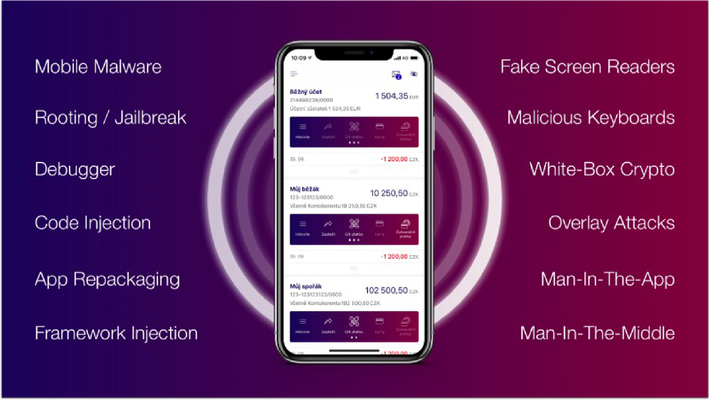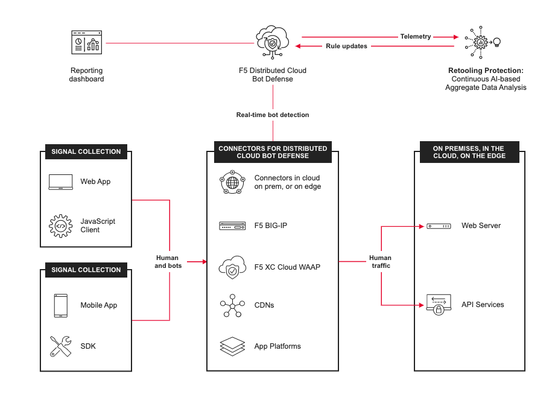series-bot-management
19 TopicsOWASP Automated Threats - Credential Stuffing (OAT-008)
Introduction: In this OWASP Automated Threat Article we'll be highlighting OAT-008 Credentials Stuffing with some basic threat information as well as a recorded demo to dive into the concepts deeper. In our demo we'll show how Credential Stuffing works with Automation Tools to validate lists of stolen credentials leading to manual Account Takeover and Fraud. We'll wrap it up by highlighting F5 Bot Defense to show how we solve this problem for our customers. Credential Stuffing Description: Lists of authentication credentials stolen from elsewhere are tested against the application’s authentication mechanisms to identify whether users have re-used the same login credentials. The stolen usernames (often email addresses) and password pairs could have been sourced directly from another application by the attacker, purchased in a criminal marketplace, or obtained from publicly available breach data dumps. Unlike OAT-007 Credential Cracking, Credential Stuffing does not involve any bruteforcing or guessing of values; instead credentials used in other applications are being tested for validity Likelihood & Severity Credential stuffing is one of the most common techniques used to take-over user accounts. Credential stuffing is dangerous to both consumers and enterprises because of the ripple effects of these breaches. Anatomy of Attack The attacker acquires usernames and passwords from a website breach, phishing attack, password dump site. The attacker uses automated tools to test the stolen credentials against many websites (for instance, social media sites, online marketplaces, or web apps). If the login is successful, the attacker knows they have a set of valid credentials. Now the attacker knows they have access to an account. Potential next steps include: Draining stolen accounts of stored value or making purchases. Accessing sensitive information such as credit card numbers, private messages, pictures, or documents. Using the account to send phishing messages or spam. Selling known-valid credentials to one or more of the compromised sites for other attackers to use. OWASP Automated Threat (OAT) Identity Number OAT-008 Threat Event Name Credential Stuffing Summary Defining Characteristics Mass log in attempts used to verify the validity of stolen username/password pairs. OAT-008 Attack Demographics: Sectors Targeted Parties Affected Data Commonly Misused Other Names and Examples Possible Symptoms Entertainment Many Users Authentication Credentials Account Checker Attack Sequential login attempts with different credentials from the same HTTP client (based on IP, User Agent, device, fingerprint, patterns in HTTP headers, etc.) Financial Application Owner Account Checking High number of failed login attempts Government Account Takeover Increased customer complaints of account hijacking through help center or social media outlets Retail Login Stuffing Social Networking Password List Attack Password re-use Use of Stolen Credentials Credential Stuffing Demo: In this demo we will be showing how attackers leverage automation tools with increasing sophistication to execute credential stuffing against the sign in page of a web application. We'll then have a look at the same attack with F5 Distributed Cloud Bot Defense protecting the application. In Conclusion: A common truism in the security industry says that there are two types of companies—those that have been breached, and those that just don’t know it yet. As of 2022, we should be updating that to something like “There are two types of companies—those that acknowledge the threat of credential stuffing and those that will be its victims.” Credential stuffing will be a threat so long as we require users to log in to accounts online. The most comprehensive way to prevent credential stuffing is to use an anti-automation platform. OWASP Links OWASP Automated Threats to Web Applications Home Page OWASP Automated Threats Identification Chart OWASP Automated Threats to Web Applications Handbook F5 Related Content Deploy Bot Defense on any Edge with F5 Distributed Cloud (SaaS Console, Automation) F5 Bot Defense Solutions F5 Labs "I Was a Human CATPCHA Solver" The OWASP Automated Threats Project OWASP Automated Threats - CAPTCHA Defeat (OAT-009) How Attacks Evolve From Bots to Fraud Part: 1 How Attacks Evolve From Bots to Fraud Part: 2 F5 Distributed Cloud Bot Defense F5 Labs 2021 Credential Stuffing Report 4.2KViews5likes0Comments
4.2KViews5likes0CommentsOWASP Automated Threats - OAT-005 Scalping
Introduction: In this OWASP Automated Threat Article we'll be highlighting OAT-005 Scalping with some basic threat information as well as a recorded demo to dive into the concepts deeper. In our demo we'll show how Automation is used to monitor and wait for goods or services to become available and then take rapid action to beat normal users to obtain them. We'll wrap it up by highlighting F5 XC Bot Defense to show how we solve this problem for our customers. Scalping Description: Acquisition of goods or services using the application in a manner that a normal user would be unable to undertake manually. Although Scalping may include monitoring awaiting availability of the goods or services, and then rapid action to beat normal users to obtain these. Scalping includes the additional concept of limited availability of sought-after goods or services, and is most well known in the ticketing business where the tickets acquired are then resold later at a profit by the scalpers. OWASP Automated Threat (OAT) Identity Number OAT-005 Threat Event Name Scalping Summary Defining Characteristics Obtain limited-availability and/or preferred goods/services by unfair methods. OAT-005 Attack Demographics: Sectors Targeted Parties Affected Data Commonly Misused Other Names and Examples Possible Symptoms Entertainment Many Users NA Bulk purchase High peaks of traffic for certain limited-availability goods or services Financial Application Owner Purchase automation Increased circulation of limited goods reselling on secondary market Retail Purchase bot Queue jumping Ticket Scalping Scalping Demo: In this demo we will be showing a simple example of how automation is used to monitor and wait for goods or services to become available and then take rapid action to beat normal users to obtain them. We'll then have a look at the same attack with F5 Distributed Cloud Bot Defense protecting the application. In Conclusion: Scalping Bots are a real problem for organization and customers as they are made up of a vast ecosystem to acquire large amounts of inventory at scale to be sold for a profit. F5 has the solutions to provide superior efficacy to interrupt and stop this unwanted automation. OWASP Links OWASP Automated Threats to Web Applications Home Page OWASP Automated Threats Identification Chart OWASP Automated Threats to Web Applications Handbook F5 Related Content Deploy Bot Defense on any Edge with F5 Distributed Cloud (SaaS Console, Automation) F5 Bot Defense Solutions The OWASP Automated Threats Project OWASP Automated Threats - CAPTCHA Defeat (OAT-009) OWASP Automated Threats - Credential Stuffing (OAT-008) OWASP Automated Threats - OAT-001 Carding Operationlizing Online Fraud Detection, Prevention, and Response JavaScript Supply Chains, Magecart, and F5 XC Client-Side Defense (Demo) How Attacks Evolve From Bots to Fraud Part: 1 How Attacks Evolve From Bots to Fraud Part: 2 F5 Distributed Cloud Bot Defense1.7KViews5likes1CommentOWASP Automated Threats - CAPTCHA Defeat (OAT-009)
Introduction: In this OWASP Automated Threat Article we'll be highlighting OAT-009 CAPTCHA Defeat with some basic threat information as well as a recorded demo to dive into the concepts deeper. In our demo we'll show how CAPTCHA Defeat works with Automation Tools to allow attackers to accomplish their objectives despite the presence of CAPTCHA's intended purpose of preventing unwanted automation. We'll wrap it up by highlighting F5 Bot Defense to show how we solve this problem for our customers. CAPTCHA Defeat Description: Completely Automated Public Turing test to tell Computers and Humans Apart (CAPTCHA) challenges are used to distinguish normal users from bots. Automation is used in an attempt to analyse and determine the answer to visual and/or aural CAPTCHA tests and related puzzles. Apart from conventional visual and aural CAPTCHA, puzzle solving mini games or arithmetical exercises are sometimes used. Some of these may include context-specific challenges. The process that determines the answer may utilise tools to perform optical character recognition, or matching against a prepared database of pre-generated images, or using other machine reading, or human farms. OWASP Automated Threat (OAT) Identity Number OAT-009 Threat Event Name CAPTCHA Defeat Summary Defining Characteristics Solve anti-automation tests. OAT-009 Attack Demographics: Sectors Targeted Parties Affected Data Commonly Misused Other Names and Examples Possible Symptoms Education Application Owners Authentication Credentials Breaking CAPTCHA High CAPTCHA solving success rate on fraudulent accounts Entertainment CAPTCHA breaker Suspiciously fast or fixed CAPTCHA solving times Financial CAPTCHA breaking Government CAPTCHA bypass Retail CAPTCHA decoding Social Networking CAPTCHA solver CAPTCHA solving Puzzle solving CAPTCHA Defeat Demo: In this demo we will be showing how it’s possible to leverage real human click farms via CAPTCHA solving services like 2CAPTCHA to bypass reCAPTCHA. We'll then have a look at the same attack with F5 Distributed Cloud Bot Defense protecting the application. In Conclusion: CAPTCHAs are only a speed bump for motivated attackers while introducing considerable friction for legitimate customers. Today, we’re at a point where bots solve CAPTCHAs more quickly and easily than most humans. Check out our additional resource links below to learn more. OWASP Links OWASP Automated Threats to Web Applications Home Page OWASP Automated Threats Identification Chart OWASP Automated Threats to Web Applications Handbook F5 Related Content Deploy Bot Defense on any Edge with F5 Distributed Cloud (SaaS Console, Automation) F5 Bot Defense Solutions F5 Labs "I Was a Human CATPCHA Solver" The OWASP Automated Threats Project How Attacks Evolve From Bots to Fraud Part: 1 How Attacks Evolve From Bots to Fraud Part: 2 F5 Distributed Cloud Bot Defense F5 Labs 2021 Credential Stuffing Report3.5KViews3likes1CommentMaking Mobile SDK Integration Ridiculously Easy with F5 XC Mobile SDK Integrator
Introduction To prevent attackers from exploiting mobile apps to launch bots, F5 provides customers with the F5 Distributed Cloud (XC) Mobile SDK, which collects signals for the detection of bots. To gain this protection, the SDK must be integrated into mobile apps, a process F5 explains in clear step-by-step technical documentation. Now, F5 provides an even easier option, the F5 Distributed Cloud Mobile SDK Integrator, a console app that performs the integration directly into app binaries without any need for coding, which means no need for programmer resources, no need to integration delays. The Mobile SDK Integrator supports most iOS and Android native apps. As a console application, it can be tied directly into CI/CD pipelines to support rapid deployments. Use Cases While motivations for using SDK Integrator may vary, below are some of the more common reasons: Emergency integrations can be accomplished quickly and correctly. Customers experiencing active bot attacks may need to integrate with F5 Distributed Cloud Bot Defense immediately and minimize integration risks. Apps using 3rd-party libraries may not be suitable for manual integration, particularly when these libraries do not provide APIs for adding HTTP headers into network requests. In such cases, the SDK Integrator can inject SDK calls into the underlying network stack, bypassing the limitations of the network library. Customers who own multiple apps, which may have different architectures, or are managed by different owners, need a single integration method, one which works for all app architectures and is simple to roll out to multiple teams. The SDK Integrator facilitates a universal integration approach. How It Works The work of the SDK Integrator is done through two commands: the first command creates a configuration profile for the SDK injection, and the second performs the injection. Step 1: $ python3 ./create_config.py --target-os Android --apiguard-config ./base_configuration_android.json --url-filter "*.domain.com/*/login" --enable-logs --outfile my_app_android_profile.dat In Step 1, apiguard-config lets the user specify the base configuration to be used in integration. With url-filter we specify the pattern for URLs which require Bot Defense protection, enable-logs allows for APIGuard logs to be seen in the console, outfile specifies the name of this integration profile. Step 2: $ java -jar SDK-Integrator.jar --plugin F5-XC-Mobile-SDK-Integrator-Android-plugin-4.1.1-4.dat --plugin my_app_android_profile.dat ./input_app.apk --output ./output_app.apk --keystore ~/my-key.keystore --keyname mykeyname --keypass xyz123 --storepass xyz123 In Step 2, we specify which SDK Integrator plugin and configuration profile should be used. In the same step, we can optionally pass parameters for app-signing: keystore, keyname, keypass and storepass. Output parameter specifies the resulting file name. The resulting .apk or .aab file is a fully integrated app, which can be tested and released. Injection steps for iOS are similar. The commands are described in greater detail in the SDK Integrator user guides distributed with the SDK Integrator. Mobile SDK Integrator Video In Conclusion In order to thwart potential attackers from capitalizing on mobile apps to initiate automated bots, The F5 Distributed Cloud Mobile SDK Integrator seamlessly incorporates the SDK into app binaries, completely bypassing the necessity for coding making the process easy and fast. Related Content Deploy Bot Defense on any Edge with F5 Distributed Cloud (SaaS Console, Automation) Protecting Your Native Mobile Apps with F5 XC Mobile App Shield Bot Defense for Mobile Apps in XC WAAP Part 1: The Bot Defense Mobile SDK2KViews4likes1CommentProtecting Your Native Mobile Apps with F5 XC Mobile App Shield
Introduction Mobile App Shield is a security technology that integrates directly into mobile applications to provide proactive security against a wide range of attacks, such as tampering, debugging, code injection, code modification and stealing of data from the app. Mobile App Shield is delivered in separate packages for iOS and for Android. Shielding an app with Mobile App Shield is an automated process. Key Capabilities F5 Distribtued Cloud (XC) Mobile App Shield contains multiple security features to counter threats found in the Android and iOS eco-system, and are outlined further below. Product Demo In this Product Demonstration we'll be showcasing Mobile App SHIELD with a product demonstration of how to both integrate SHIELD while also highlighting the protection it provides Conclusion Mobile App Shield represents an advanced security technology seamlessly embedded within mobile applications, offering proactive protection against a diverse array of threats and is easily coupled with XC Bot Defense for comprehensive Mobile App Protection for both Android and iOS. Related Content Deploy Bot Defense on any Edge with F5 Distributed Cloud (SaaS Console, Automation) Bot Defense for Mobile Apps in XC WAAP Part 1: The Bot Defense Mobile SDK F5 Bot Defense Solutions F5 Fraud Solutions F5 Authentication Intelligence The OWASP Automated Threats Project OWASP Automated Threats - CAPTCHA Defeat (OAT-009) OWASP Automated Threats - Credential Stuffing (OAT-008) OWASP Automated Threats - OAT-001 Carding Operationlizing Online Fraud Detection, Prevention, and Response JavaScript Supply Chains, Magecart, and F5 XC Client-Side Defense (Demo) How Attacks Evolve From Bots to Fraud Part: 1 How Attacks Evolve From Bots to Fraud Part: 2 F5 Distributed Cloud Bot Defense (Overview and Demo)4.1KViews5likes2CommentsDeploy Bot Defense on any Edge with F5 Distributed Cloud (SaaS Console, Automation)
Introduction This guide, along with the provided scripts and sample app and services, is designed to help explore and demonstrate the use cases of the F5 Distributed Cloud (XC) Bot Defense in a variety of different cloud environments including AWS, Azure, GCP, and within the Distributed Cloud (XC) Regional Edge. XC Bot Defense Connector Strategy F5 Distributed Cloud Bot Defense meets you where you’re at when it comes to deployment flexibility. We make it ridiculously easy for you to deploy XC Bot Defense either in the cloud, on-prem, or as a hybrid configuration with pre-built connecters in leading application platforms and CDNs to make deployment easy and fast. Choose Your Path Within each deployment scenario, you can choose your path with the following options to deploy the specified Bot Defense environment using either the console deployment link or automation with terraform. Module 1 Deploy Bot Defense on Regional Edges with F5 Distributed Cloud Module 2 Deploy F5 XC Bot Defense for AWS Cloudfront with F5 Distributed Cloud Module 3 Deploy Bot Defense in Azure with BIG-IP Connector for F5 Distributed Cloud Module 4 Deploy Bot Defense in GCP Using BIG-IP Connector for F5 Distributed Cloud XC Bot Defense Scenarios The modules below lay out a framework for connecting and managing distributed app services for this scenario, with a focus on the three core use cases. MODULE 1: Deploy Bot Defense on Regional Edges with F5 Distributed Cloud In this scenario, we will be deploying our fictitious airline application into a Regional Edge location of our choosing via the VK8's service in XC. We'll walk through all of the required steps, provide the vk8's manifest file and front end this application with an XC HTTP Load Balancer. In addition, the HTTP Load Balancer will be used to front-end our application and enable our XC Bot Defense Service. Choose your path: Console Steps for XC Bot Defense on Regional Edges Automated Deployment of XC Bot Defense on Regional Edge via Terraform MODULE 2: Deploy F5 XC Bot Defense for AWS Cloudfront with F5 Distributed Cloud In this scenario, we will be deploying our fictitious application in AWS with the XC Bot Defense Connector for AWS Cloudfront Distributions. Choose your path: Console Steps to Deploy F5 XC Bot Defense for AWS Cloudfront Coming Soon*** Automated Deployment of XC Bot Defense for AWS Cloudfront MODULE 3: Deploy Bot Defense in Azure with BIG-IP Connector for F5 Distributed Cloud In this scenario, we will be deploying our fictitious application into Azure with the XC Bot Defense Connector for BIG-IP. Choose your path: Console Steps to Deploy F5 XC Bot Defense in Azure with BIG-IP Connector Automated Deployment of XC Bot Defense in Azure with BIG-IP Connector MODULE 4: Deploy Bot Defense in GCP Using BIG-IP Connector for F5 Distributed Cloud In this scenario, we will be deploying our fictitious application into GCP with the XC Bot Defense Connector for BIG-IP. Choose your path: Console Steps to Deploy F5 XC Bot Defense in GCP Using BIG-IP Connector Automated Deployment of XC Bot Defense in GCP with BIG-IP Connector For additional information, refer to these resources: Deploy Bot Defense on any Edge with F5 Distributed Cloud (SaaS Console, Automation) GitHub repository with the walk-through of the deployment steps & demo YouTube video series discussing the different aspects of this configuration DevCentral Learning Series: Edge Compute Get Started with F5 Distributed Cloud Services1.3KViews4likes2CommentsHow Attacks Evolve From Bots to Fraud - Part 2
In our previous article we discussed how an attackers sophistication evolves in order to bypass anti-automation countermeasures and achieve their actions on the target. In this article and video we walk through some specific automated attack tools and test them against a real endpoint protected by F5 Bot Defense to get a real look at this scenario. When it comes to an attacker being successful with their automation toolkit, it heavily depends on the Anti-Automation solution that is protecteing the web property they are attacking and the sophistication of the attacker. In order to bypass any countermeasures the attacker must make the attack look as human as possible. Let's briefly discuss the different tools we'll be using in our demo starting with low sophistication and ending with a higher sophistication attack. Low sophistication Attacks (e.g. CURL): for run in {1..10} do curl -s 'https://credstuff.acmecorp.com/user/signin' -i -X POST -d "username=1&password=1" > /dev/null echo echo CURL Credential Stuffing attempt $run done sleep 2 done Sample: CURL Script performing basic credential stuffing HTTP POST example CURL is a tool that almost everyone uses these days to transfer data from or to a server, using one of the supported protocols (DICT, FILE, FTP, FTPS, GOPHER, HTTP, HTTPS, IMAP, IMAPS, LDAP, LDAPS, POP3, POP3S, RTMP, RTSP, SCP, SFTP, SMB, SMBS, SMTP, SMTPS, TELNET and TFTP). The command is designed to work without user interaction so of course it lends itself well to automation both good and bad. CURL offers a busload of useful tricks like proxy support, user authentication, FTP upload, HTTP post, SSL connections, cookies, file transfer resume, Metalink, and more. The number of features will make your head spin but it can also facilitate malicious activity and potentially fool origin servers that don't have proper checks in place. CURL can be used to generate automated credential stuffing attacks do to the massive amount of features CURL can generate much of the network traffic, headers, user agents strings and such that a real browser would. This can be used to fool origin servers into thinking it is a real browser and not an automated login attempt. Medium sophistication (e.g. Open Bullet 2) OpenBullet 2 is a cross platform automation suite powered by .NET core. It allows users to perform requests towards a target webapp and offers a lot of tools to work with the results. This software can be used for scraping and parsing data, automated pentesting and much more. This tool can also be used maliciously by attackers for Credential Stuffing and other automated web threats. It allows the user to import proxy lists, build automated attack configurations, leverage third party CAPTCHA solvers, and much more. High sophistication (e.g. Selenium with Python) from selenium import webdriver from selenium.webdriver.common.keys import Keys driver = webdriver.Firefox() driver.get("http://www.python.org") assert "Python" in driver.title elem = driver.find_element_by_name("q") elem.clear() elem.send_keys("pycon") elem.send_keys(Keys.RETURN) assert "No results found." not in driver.page_source driver.close() Sample: Selenium Python Script performing basic browser automation function Selenium is an umbrella project for a range of tools and libraries that enable and support the automation of web browsers. Selenium supports automation of all the major browsers in the market through the use of WebDriver. WebDriver is an API and protocol that defines a language-neutral interface for controlling the behaviour of web browsers. With this ability to automate Web Browsers through the use of scripting can also lend itself to enabling an attacker to attempt to bypass many anti-automation solutions for a variety of different attacks. OWASP has defined a list of many of the different Automated Threats here... Learn more about the Selenium Browser Automation Project here Video Description: Automated attack tools are evolving quickly. Increasing scale, sophistication, and human emulation gives threat actors better chances of bypassing existing Bot Defense countermeasures leading to Account Takeover and Fraud. In this session we'll demonstrate how attacks evolve from bots to fraud. Hope you guys enjoyed this Overview and Demo. If there are any comments or questions please feel free to reach us in the comments section. Thanks! Related Content: Deploy Bot Defense on any Edge with F5 Distributed Cloud (SaaS Console, Automation) How Attacks Evolve From Bots to Fraud Part: 1 F5 Bot Management 2.1KViews4likes0Comments
2.1KViews4likes0CommentsHow Attacks Evolve from Bots to Fraud - Part 1
Bot Basics A bot is a software program that performs automated, repetitive, pre-defined tasks. Bots typically imitate or replace human user behavior because they operate much faster than human users. Good Bots make the Internet work - From search engine crawlers that bring the world to your fingertips to chatbots that engage and enhance the user experience. How Do Bots Facilitate Fraud? Bots can also be used to scale automated attacks which can result in account takeover (ATO) and fraud. Motivated cyber criminals leverage a sophisticated arsenal of bots, automation, and evasion techniques. They also perform ongoing reconnaissance to identify security countermeasures and constantly retool their attacks to evade detection. Automated Bot Attack Vector Examples... Credential Stuffing Automated Account Creation Content Scraping High Value Data Credit Application Fraud Gift Card Cracking Application DDoS Aggregator Threats Fake Account Creation Inventory Hoarding Bypass Auth reCAPTCHA The list goes on... Business Impact of Bad Bots Infrastructure Costs - Infrastructure needs to scale to deal with unwanted and/or undetected bot traffic Competitive Intelligence - Web scrapers collect important data to help competitors adjust their pricing strategies Wrong Business Decisions - Bot traffic distorts web site analytics which could lead to making wrong business decisions Sneaker Bots - Bots are buying limited editions of certain products before regular buyers and then sell on black market Account Take-over - Credential stuffing leveraging stolen accounts purchased on the Darkweb providing access Fraudulent Transactions - Fraudulent transactions with large financial consequences as a result of account take-over in the finance sector The Industrialized (organized) Attack Lifecycle Figure 1. It begins with unwanted automation and ends with account takeover and application fraud What are Credential Spills? Credential Spill - A cyber incident in which a combination of username and/or email and password pairs becomes compromised. Date of Announcement - The first time a credential spill becomes public knowledge. This announcement could occur in one of two ways: A breached organization alerts its users and/or the general public A security researcher or reporter discovers a credential spill and breaks the news Date of Discovery - When an organization first learned of its credential spill. Organizations are not always willing to share this information. Stolen Credentials - Criminal Usage by Stage Stage 1: Slow and Quiet Sophisticated threat actors operating in stealth mode - 150 to - 30 days before the public announcement Each credential used (on average) 20 times per day Figure 2. Slow and quiet stage. Attackers use credentials in stealth mode from 150 to 30 days before the public announcement Stage 2: Ramp Up Creds become available on Darknet around ~30 days before public announcement Use of creds ramp up to 70 times per day Figure 3. The ramp-up stage. Attackers ramp up use of compromised credentials 30 days before the public announcement. Stage 3: The Blitz Credentials become public knowledge Script Kiddies + N00bs The first week is absolute chaos - each account attacked > 130 times per day Figure 4. The blitz stage. Script kiddies and other amateurs race to use credentials after the public announcement. Stage 4: Drop-Off / New Equilibrium Creds *should* be worthless at this point... Consumer reuse and lack of change allows for attacker "repackaging" and long tail value Figure 5. The drop-off stage. Credentials no longer have premium value Network Traffic Automation The simplest level of user simulation contains tools that make no attempt to emulate human behavior or higher level browser activity. They simply craft HTTP requests along specified parameters and pass them along to the target. These are the simplest, cheapest, and fastest tools. Sentry MBA is perhaps the standard tool of this type. Figure 6. Sentry MBA, a standard user simulation tool Browser and Native App Automation Most of the websites that we interact with every day—online banking, ecommerce, and travel sites—consist of large web applications built on hundreds of thousands of lines of JavaScript. These webpages are not simple documents, so simulating convincing transactions at the network level is extremely complex. At this point, it makes more sense for an attacker to automate activity at the browser level. Until 2017, PhantomJS was the most popular automated browser in the market. When Google released Chrome 59 that year, however, it pushed forward the state of browser automation by exposing a programmatically controllable “headless” mode (that is, absent a graphical user interface) for the world's most popular browser, Chrome. This gave attackers the ability to quickly debug and troubleshoot their programs using the normal Chrome interface while scaling their attacks. Furthermore, just weeks after this announcement, Google developers released Puppeteer, a cross-platform Node.js library that offers intuitive APIs to drive Chrome-like and Firefox browsers. Puppeteer has since become the go-to solution for browser automation, as you can see from its growing popularity in web searches. Figure 7. Google trends graph showing interest in PhantomJS versus Puppeteer between 2010 and 2016. (Source: Google Trends) Simulating Human Behavior The next level of sophistication above simulating a browser is simulating human behavior. It's easy to detect rapid, abrupt mouse movements and repeated clicks at the same page coordinates (such as a Submit button), but it is much harder to detect behavior that includes natural motion and bounded randomness. While Puppeteer and the Chrome DevTools Protocol can generate trusted browser events, such as clicks or mouse movements, they have no embedded functionality to simulate human behavior. Even if perfect human behavior was as simple as including a plug-in, Puppeteer is still a developer-oriented tool that requires coding skill. Enter Browser Automation Studio, or BAS. BAS is a free, Windows-only automation environment that allows users to drag and drop their way to a fully automated browser, no coding needed. Figure 8. Browser Automation Studio User Interface Scaling Up Real Human Behavior As attackers grow in capability, they succeed in creating automated attacks that look more like human behavior. In some contexts, it actually makes more sense to just use actual humans. "Microwork" is a booming industry in which anyone can farm out small tasks in return for pennies. These services describe their jobs as ideal for labeling data destined for machine learning systems and, in theory, that would be a perfect use. In reality, the tasks the human workers perform are helping bypass antibot defenses on social networks, retailers, and any site with a login or sign-up form. Figure 9. Data labeling “microwork” using humans to help bypass antibot defenses In Conclusion Depending on the attacker sophistication level and motivation there are a variety of tools ranging from basic automation to leveraging real humans to attempt to bypass bot defenses and perform account takeover actions. No matter the skill level, most attackers (at least, most cybercriminals) will start off with the cheapest, that is, least sophisticated, attacks in order to maximize rate of return. Able attackers will only increase sophistication (and thereby cost) if their target has implemented countermeasures that detect their original attack, and if the rewards still outweigh that increased cost. Related Content: Deploy Bot Defense on any Edge with F5 Distributed Cloud (SaaS Console, Automation) How Attacks Evolve From Bots to Fraud - Part 2 F5 Labs 2021 Credential Stuffing Report3.5KViews3likes0CommentsBots, Fraud, and the OWASP Automated Threats Project (Overview)
Introduction Many of us have heard of OWASP in the context of the OWASP Top 10. In this article series we will take a look at another very important threat classification list called the OWASP Automated Threats (OAT) Project and provide a foundational overview. The terms Malicious Bot and Automated Threat can be used interchangeably throughout. In future articles we'll dive deeper into individual key threats called OATs and demonstrate how these attacks work and how to defend against them. Why should we care about the OWASP Automated Threats Project? Web security is no longer constrained to inadvertent vulnerabilities and attackers are abusing inherent functionality to conduct Automated and Manual Fraud. Existing technologies are not capable of detecting advanced automated abuse, fraud teams can’t keep up with new fraud mechanisms, while web users are increasingly adverse to encountering Authentication Friction created by legacy or traditional bot defenses like CAPTCHAs. From its original release in 2015, the OWASP Automated Threat Handbook has now become a de facto industry standard in classifying Bots and better understanding all aspects of Malicious Web Automation. What OATs Are Not - Not another vulnerability list - Not an OWASP Top N List - Not threat modelling - Not attack trees - Not non web - Not non application What Are OATs (aka Malicous Bots)? In order to quantify these threats, it is necessary to be able to name them. OAT stands for OWASP Automated Threat and there are currently 21 attack vectors defined. Currently OAT codes 001 to 021 are used. Within each OAT the Threat definition contains a description, the sectors targeted, parties affected, the data commonly misused, and external cross mappings to other lists like CAPEC Category, possible symptoms, suggested countermeasures, etc... Here is the Full List of OATs ordered by ascending name: Identifier OAT Name Summary Defining Characteristics OAT-020 Account Aggregation Use by an intermediary application that collects together multiple accounts and interacts on their behalf OAT-019 Account Creation Create multiple accounts for subsequent misuse OAT-003 Ad Fraud False clicks and fraudulent display of web-placed advertisements OAT-009 CAPTCHA Defeat Solve anti-automation tests OAT-010 Card Cracking Identify missing start/expiry dates and security codes for stolen payment card data by trying different values OAT-001 Carding Multiple payment authorisation attempts used to verify the validity of bulk stolen payment card data OAT-012 Cashing Out Buy goods or obtain cash utilising validated stolen payment card or other user account data OAT-007 Credential Cracking Identify valid login credentials by trying different values for usernames and/or passwords OAT-008 Credential Stuffing Mass log in attempts used to verify the validity of stolen username/password pairs OAT-021 Denial of Inventory Deplete goods or services stock without ever completing the purchase or committing to the transaction OAT-015 Denial of Service Target resources of the application and database servers, or individual user accounts, to achieve denial of service (DoS) OAT-006 Expediting Perform actions to hasten progress of usually slow, tedious or time-consuming actions OAT-004 Fingerprinting Elicit information about the supporting software and framework types and versions OAT-018 Footprinting Probe and explore application to identify its constituents and properties OAT-005 Scalping Obtain limited-availability and/or preferred goods/services by unfair methods OAT-011 Scraping Collect application content and/or other data for use elsewhere OAT-016 Skewing Repeated link clicks, page requests or form submissions intended to alter some metric OAT-013 Sniping Last minute bid or offer for goods or services OAT-017 Spamming Malicious or questionable information addition that appears in public or private content, databases or user messages OAT-002 Token Cracking Mass enumeration of coupon numbers, voucher codes, discount tokens, etc OAT-014 Vulnerability Scanning Crawl and fuzz application to identify weaknesses and possible vulnerabilities Automated Threats Breakdown By Industry Within each OAT definition there is a section for the Sectors Targeted for that particular attack vector. For example, a Carding Attack would be seen on ecommerce and retail type of sites with payment card processing. Here they would be able to validate a list of stolen credit card numbers to identify the working ones from non working. Example: OAT-001 Carding Attack example highlighting "Sectors Targeted" for this type of attack. This exists for each attack definition. OWASP Defined Countermeasures Countermeasure Classes: The technology and vendor agnostic countermeasure classes attempt to group together the types of design, development and operational controls identified from research that are being used to partially or fully mitigate the likelihood and/or impact of automated threats to web applications. In all applications, builder-defender collaboration is key in controlling and mitigating automated threats – the best protected applications do not rely solely upon standalone external operational protections, but also have integrated protection built into the design. Similarly to other types of application security threat, it is important to build consideration of automated threats into multiple phases of a secure software development lifecycle (S-SDLC). 14 Countermeasure Classes: Value Authentication Requirements Rate Testing Monitoring Capacity Instrumentation Obfuscation Contract Fingerprinting Response Reputation Sharing Countermeasure Controls Countermeasures are controls that attempt to mitigate the identified automated threats in three ways: Prevent - Controls to reduce the susceptibility to automated threats Detect - Controls to identify whether a user is an automated process rather than a human, and/or to identify if an automated attack is occurring, or occurred in the past Recover - Controls to assist response to incidents caused by automated threats, including to mitigate the impact of the attack, and to to assist return of the application to its normal state. Cross References Other Threat Mappings Each OAT Threat is cross referenced with other external threat lists to provide and understanding of how this OAT Handbook can be integrated with other works. Example, OAT Threat below shows the cross referenced CAPEC, CWE, and WASC Threat ID's You can find links to each of the external classification models below: Mitre CAPEC - best full and/or partial match CAPEC category IDs and/or attack pattern IDs WASC Threat Classification - best match to threat IDs Mitre Common Weakness Enumeration - closely related base, class & variant weakness IDs Matching pages defining terms classified as Attacks on the OWASP wiki Youtube Conclusion In conclusion, the OWASP Automated Threat Handbook has now become a de facto industry standard in classifying and better understanding all aspects of malicious web automation. We can use this handbook to build secure software development lifecycles around our web properties and implement the appropriate countermeasure to prevent unwanted automation against them. OWASP Links OWASP Automated Threats to Web Applications Home Page OWASP Automated Threats Identification Chart OWASP Automated Threats to Web Applications Handbook F5 Related Content Deploy Bot Defense on any Edge with F5 Distributed Cloud (SaaS Console, Automation) How Attacks Evolve From Bots to Fraud Part: 1 How Attacks Evolve From Bots to Fraud Part: 2 F5 Distributed Cloud Bot Defense F5 Labs 2021 Credential Stuffing Report4.5KViews2likes0CommentsF5 Distributed Cloud Bot Defense (Overview and Demo)
What is Distributed Cloud Bot Defense? Distributed Cloud Bot Defense protects your web properties from automated attacks by identifying and mitigating malicious bots. Bot Defense uses JavaScript and API calls to collect telemetry and mitigate malicious users within the context of the Distributed Cloud global network. Bot Defense can easily be integrated into existing applications in a number of ways. For applications already routing traffic through Distributed Cloud Mesh Service, Bot Defense is natively integrated into your Distributed Cloud Mesh HTTP load balancers. This integration allows you to configure the Bot Defense service through the HTTP load balancer's configuration in the Distributed Cloud Console. For other applications, connectors are available for several common insertion points that likely already exist in modern application architectures. Once Bot Defense is enabled and configured, you can view and filter traffic and transaction statistics on the Bot Defense dashboard in Distributed Cloud Console to see which users are malicious and how they’re being mitigated. F5 Distributed Cloud Bot Defense is an advanced add-on security feature included in the first launch of the F5 Web Application and API Protection (WAAP) service with seamless integration to protect your web apps and APIs from a wide variety of attacks in real-time. High Level Distributed Cloud Security Architecture Bot Defense Demo: In this technical demonstration video we will walk through F5 Distributed Cloud Bot Defense, showing you how quick and easy it is to configure, the insights and visibility you have while demonstrating a couple of real attacks with Selenium and Python browser automation. "Nature is a mutable cloud, which is always and never the same." - Ralph Waldo Emerson We might not wax that philosophically around here, but our heads are in the cloud nonetheless! Join the F5 Distributed Cloud user group today and learn more with your peers and other F5 experts. Hope you enjoyed this Distributed Cloud Bot Defense Overview and Demo. If there are any comments or questions please feel free to reach us in the comments section. Thanks! Related Resources: Deploy Bot Defense on any Edge with F5 Distributed Cloud (SaaS Console, Automation) Protecting Your Web Applications Against Critical OWASP Automated Threats Making Mobile SDK Integration Ridiculously Easy with F5 XC Mobile SDK Integrator JavaScript Supply Chains, Magecart, and F5 XC Client-Side Defense (Demo) Bots, Fraud, and the OWASP Automated Threats Project (Overview) Protecting Your Native Mobile Apps with F5 XC Mobile App Shield Enabling F5 Distributed Cloud Client-Side Defense in BIG-IP 17.1 Bot Defense for Mobile Apps in XC WAAP Part 1: The Bot Defense Mobile SDK F5 Distributed Cloud WAAP Distributed Cloud Services Overview Enable and Configure Bot Defense - F5 Distributed Cloud Service8.6KViews2likes0Comments







